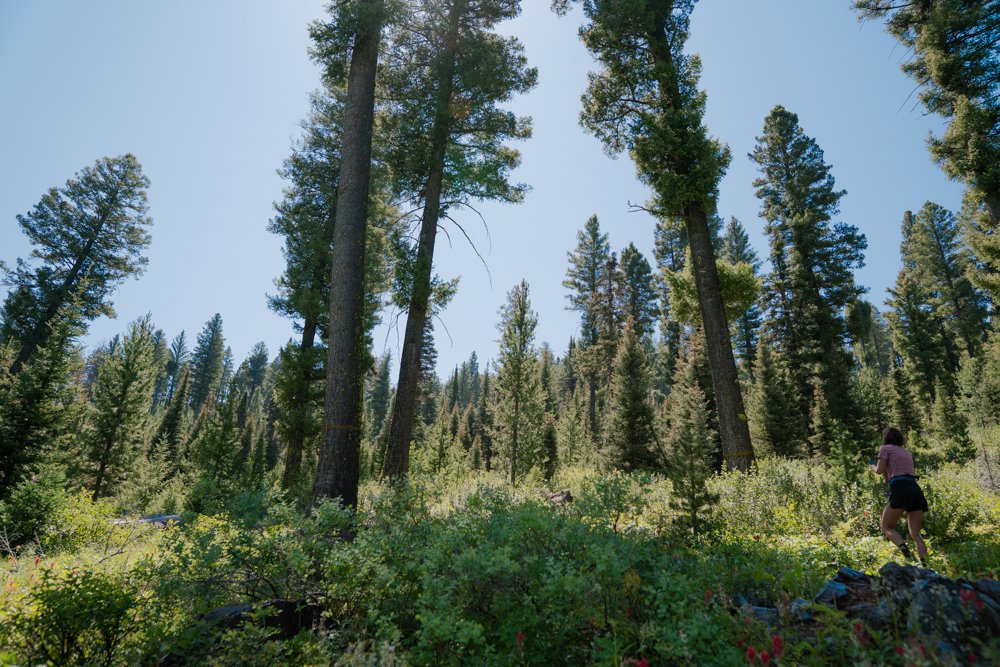The Kilgore Project's second Environmental Assessment still leaves room for risk to water and wildlife
On Tuesday, January 12, 2021 the U.S. Forest Service released a new Draft Environmental Assessment for the Kilgore Gold Exploration Project, 3-5 years of gold exploration proposed in the foothills of the Centennial Mountains near Kilgore, about 80 miles north of Idaho Falls on the Targhee National Forest. The proposed exploration is the first step in Canadian mining company Excellon Resources’ ultimate goal of mining the area’s gold with an open-pit cyanide heap leach mine.
GYC Idaho Conservation Associate Allison Michalski hikes near the Kilgore Project exploration site. (Photo GYC/Emmy Reed)
The project area is within a rugged and vital landscape, important to wildlife and Idaho hunters, anglers, and farmers alike. These foothills provide critical habitat for big game; landscape connectivity for grizzlies; clean water for prized Yellowstone cutthroat trout, downstream agriculture, and drinking water supplies; and recreational opportunities that keep Idaho’s outdoor heritage alive.
Despite the ecological and cultural significance of the area, Excellon has had its sights set on mining this landscape for some time. Last year, GYC and Idaho Conservation League - represented by Advocates for the West and the Western Mining Action Project - successfully challenged the proposal’s first environmental assessment in federal court. In that decision, the judge agreed with us and ruled that the Forest Service failed to evaluate the impacts of drilling operations to water quality and Yellowstone cutthroat trout, a Forest Service “sensitive species.” The ruling held that exploration activities at Kilgore could not proceed until the Forest Service adequately addressed these issues.
Fast forward to early this week, when the Forest Service released the new draft environmental assessment, which ostensibly should address the issues outlined by the court. However, our preliminary analysis of the new Draft Environmental Assessment reveals a very similar project to what Excellon previously proposed, with the same intensive road construction and drilling that would degrade important habitat for endangered or imperiled species like grizzly bears, lynx, whitebark pine, and Yellowstone cutthroat trout. Exploration activates could also disrupt the migration patterns of elk and other game animals prized by Idaho outdoors people.
This new assessment does little to address the court’s concerns about fish habitat and water quality impacts to this rugged and vital terrain. It goes without saying that Idahoans deserve more than a cursory rubber stamp when it comes to their wildlife and water resources.
While our focus now is on the substantial environmental impacts that an intensive gold exploration project can have on a landscape like the Centennial foothills (think construction of 130 drilling stations, 10.2 miles of new roads, and all the dust, sedimentation, and noise pollution that comes with operating drill pads 24 hours a day, seven days a week for 3-5 years), it is important to note that on the other end of a successful exploration project is an extensive cyanide heap leach mining operation. Based on the ore deposits, it is likely that the only economically viable way for the company to mine the area is with cyanide heap leaching. Cyanide heap leach mining is a process so notorious for the damage it causes, that if the proposed mine site was located approximately ten miles to the north across the Montana border, it would be illegal.
Updated 2/12/21: The Forest Service has closed its public comment period on the Draft Environmental Assessment for the Kilgore Gold Exploration Project. Thanks to you, we submitted over 3,000 comments to the Forest Service opposing this risky project!
Let me know if you have any questions about the Kilgore Gold Exploration Project!
-Allison Michalski, Idaho Conservation Associate


